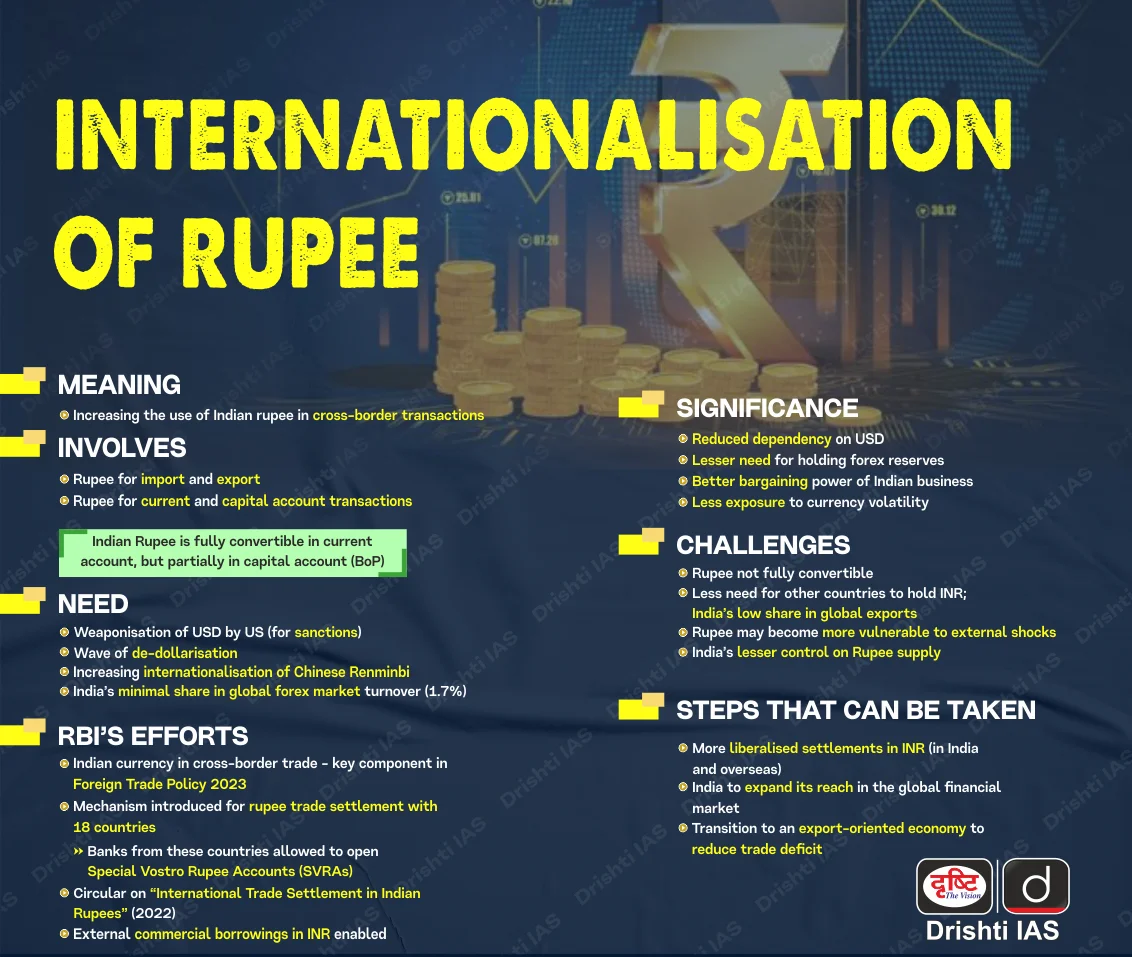Credit Reforms to Deepen Financial Markets | 09 Oct 2025
Why in News?
The Reserve Bank of India (RBI) announced a set of credit reforms to deepen financial markets, enhance the role of banks in corporate consolidation, and advance rupee internationalisation, amid rising trade tensions with the US and renewed BRICS currency discussions on alternatives to the US dollar.
What are the Key Credit Reforms Announced by RBI?
- Finance Mergers and Acquisitions (M&As): For the first time, banks in India can lend directly for corporate takeovers (earlier dominated by Non-Banking Financial Companies (NBFCs) and private funds), a domain previously restricted due to concerns over misuse, promoter risk, and credit concentration.
- Rupee-Denominated Lending: Indian banks can now lend in rupees to neighbours like Nepal, Bhutan, and Sri Lanka.
- This move aims to reduce dollar dependence in regional trade and settlements, provide rupee liquidity, and promote the internationalisation of the rupee while strengthening India’s monetary influence.
- Increasing Capital Market Lending Limits: The loan limit against shares has been raised to Rs 1 crore (from Rs 20 lakh), and Initial Public Offering (IPO) financing limit increased to Rs 25 lakh (from Rs 10 lakh).
- These measures aim to improve access to market-based financing and energise primary capital markets.
- Use of SRVA in Corporate Debt: Funds in Special Rupee Vostro Accounts (SRVAs), can now be invested in corporate bonds and commercial papers, not just government securities.
- It strengthens rupee liquidity and deepens India’s bond market.
- Expanded Currency Benchmarks: The Financial Benchmarks India Limited (FBIL) will include more partner currencies beyond USD, Euro, Pound, and Yen. It enables direct forex quotes with more countries and reduces dollar dependence.
- Revised Basel III Capital Norms: From April 2027, RBI will implement revised Basel III capital adequacy norms for commercial banks.
- The new standards are expected to reduce capital requirements for certain sectors, particularly MSMEs and residential real estate loans, by introducing lower risk weights for these sectors.
- This aims to boost banks' capital adequacy ratios while maintaining financial stability.
Financial Markets in India
- About: Financial markets are platforms where securities like stocks, bonds, and currencies are traded.
- These markets, including forex, bond, stock, money, and derivatives markets, play a crucial role in a country's economic growth.
- Components of Financial Markets in India:
- Money Market: Deals with short-term financial instruments (less than one year), facilitating borrowing and lending between banks and financial institutions.
- Capital Markets: Involves long-term instruments (over one year). It includes the primary market (new securities) and secondary market (existing securities).
- Foreign Exchange Market: Facilitates currency trading, crucial for international trade and investment.
- Derivatives Market: Involves trading instruments like options and futures that derive value from underlying assets.
- Importance of Financial Markets: It supports capital raising, risk management, and contributes to economic stability and growth. They are essential for businesses, investors, and overall economic development.
- A failure in these markets can lead to recession and unemployment.
What are the Implications of the Credit Reforms by RBI?
- Enhanced Capital Access: By allowing banks to fund takeovers, corporates now have access to low-cost, structured finance for scaling operations.
- However, this also increases exposure to promoter risk and demands enhanced credit appraisal, monitoring, and governance safeguards to prevent asset quality deterioration.
- Corporate Sector Empowerment: Easier access to structured bank finance enables well-governed companies to undertake strategic expansions and sectoral consolidation.
- This is likely to catalyse growth in key sectors like infrastructure, energy, logistics, and manufacturing, improving global competitiveness.
- Rupee Internationalisation: Allowing rupee-denominated loans to neighbours positions India as a regional financial anchor. These reforms serve as a counterweight to global currency blocs, offering a practical alternative through rupee-based trade and credit.
- Enabling investments of surplus SRVA balances into Indian corporate bonds further builds international confidence in Indian markets and deepens rupee liquidity abroad.
Click here to Read: Internationalization of Rupee
|
Drishti Mains Question: Critically evaluate the role of Reserve Bank of India (RBI) in strengthening India’s financial markets and promoting global competitiveness |
Frequently Asked Questions (FAQs)
1. What new lending freedom has RBI given to banks?
Banks can now finance mergers and acquisitions (M&As), a space earlier dominated by NBFCs.
2. How do rupee-denominated loans to neighbours help India?
They promote rupee internationalisation and reduce dollar dependence in regional trade.
3. What new use is allowed for Special Rupee Vostro Accounts (SRVAs) balances?
Surplus SRVA funds can now be invested in corporate bonds and commercial papers.
UPSC Civil Services Examination, Previous Year Questions (PYQs)
Prelims
Q. Convertibility of rupee implies (2015)
(a) being able to convert rupee notes into gold
(b) allowing the value of rupee to be fixed by market forces
(c) freely permitting the conversion of rupee to other currencies and vice versa
(d) developing an international market for currencies in India
Ans: (c)
Mains
Q. Do you agree with the view that steady GDP growth and low inflation have left the Indian economy in good shape? Give reasons in support of your arguments? (2019)

